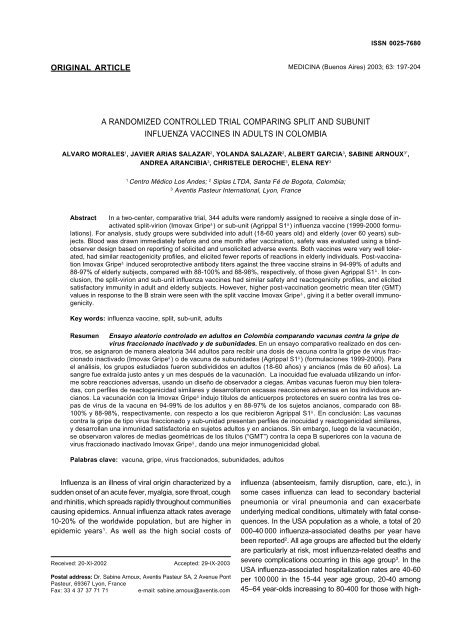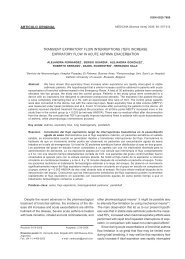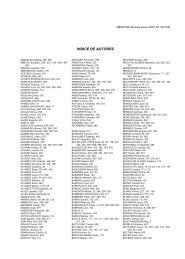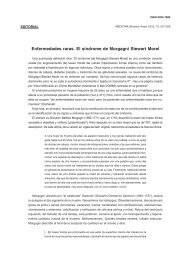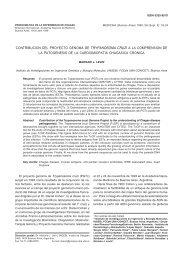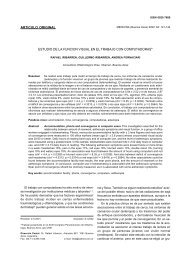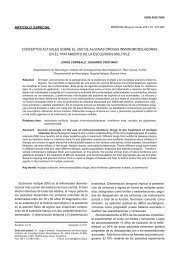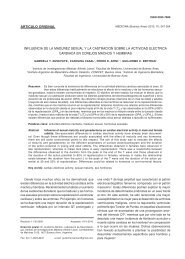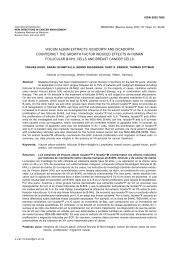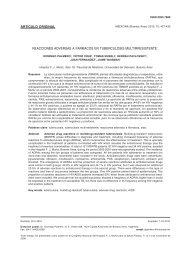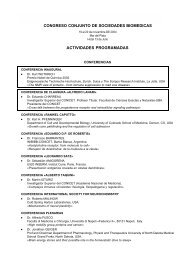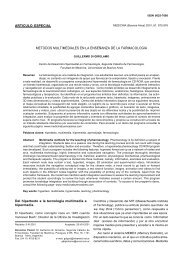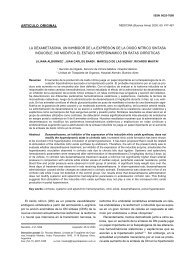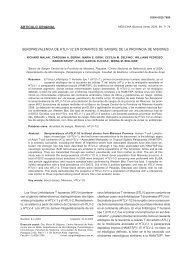A RANDOMIZED CONTROLLED TRIAL COMPARING SPLIT AND ...
A RANDOMIZED CONTROLLED TRIAL COMPARING SPLIT AND ...
A RANDOMIZED CONTROLLED TRIAL COMPARING SPLIT AND ...
Create successful ePaper yourself
Turn your PDF publications into a flip-book with our unique Google optimized e-Paper software.
CLINICAL COMPARISON OF <strong>SPLIT</strong> <strong>AND</strong> SUB-UNIT INFLUENZA VACCINESISSN 0025-7680 197ORIGINAL ARTICLE MEDICINA (Buenos Aires) 2003; 63: 197-204A <strong>R<strong>AND</strong>OMIZED</strong> <strong>CONTROLLED</strong> <strong>TRIAL</strong> <strong>COMPARING</strong> <strong>SPLIT</strong> <strong>AND</strong> SUBUNITINFLUENZA VACCINES IN ADULTS IN COLOMBIAALVARO MORALES 1 , JAVIER ARIAS SALAZAR 2 , YOL<strong>AND</strong>A SALAZAR 2 , ALBERT GARCIA 3 , SABINE ARNOUX 3* ,<strong>AND</strong>REA ARANCIBIA 3 , CHRISTELE DEROCHE 3 , ELENA REY 31Centro Médico Los Andes; 2 Siplas LTDA, Santa Fé de Bogota, Colombia;3Aventis Pasteur International, Lyon, FranceAbstract In a two-center, comparative trial, 344 adults were randomly assigned to receive a single dose of inactivatedsplit-virion (Imovax Gripe â ) or sub-unit (Agrippal S1 â ) influenza vaccine (1999-2000 formulations).For analysis, study groups were subdivided into adult (18-60 years old) and elderly (over 60 years) subjects.Blood was drawn immediately before and one month after vaccination, safety was evaluated using a blindobserverdesign based on reporting of solicited and unsolicited adverse events. Both vaccines were very well tolerated,had similar reactogenicity profiles, and elicited fewer reports of reactions in elderly individuals. Post-vaccinationImovax Gripe â induced seroprotective antibody titers against the three vaccine strains in 94-99% of adults and88-97% of elderly subjects, compared with 88-100% and 88-98%, respectively, of those given Agrippal S1 â . In conclusion,the split-virion and sub-unit influenza vaccines had similar safety and reactogenicity profiles, and elicitedsatisfactory immunity in adult and elderly subjects. However, higher post-vaccination geometric mean titer (GMT)values in response to the B strain were seen with the split vaccine Imovax Gripe â , giving it a better overall immunogenicity.Key words: influenza vaccine, split, sub-unit, adultsResumen Ensayo aleatorio controlado en adultos en Colombia comparando vacunas contra la gripe devirus fraccionado inactivado y de subunidades. En un ensayo comparativo realizado en dos centros,se asignaron de manera aleatoria 344 adultos para recibir una dosis de vacuna contra la gripe de virus fraccionadoinactivado (Imovax Gripe â ) o de vacuna de subunidades (Agrippal S1 â ) (formulaciones 1999-2000). Parael análisis, los grupos estudiados fueron subdivididos en adultos (18-60 años) y ancianos (más de 60 años). Lasangre fue extraída justo antes y un mes después de la vacunación. La inocuidad fue evaluada utilizando un informesobre reacciones adversas, usando un diseño de observador a ciegas. Ambas vacunas fueron muy bien toleradas,con perfiles de reactogenicidad similares y desarrollaron escasas reacciones adversas en los individuos ancianos.La vacunación con la Imovax Gripe â indujo títulos de anticuerpos protectores en suero contra las tres cepasde virus de la vacuna en 94-99% de los adultos y en 88-97% de los sujetos ancianos, comparado con 88-100% y 88-98%, respectivamente, con respecto a los que recibieron Agrippal S1 â . En conclusión: Las vacunascontra la gripe de tipo virus fraccionado y sub-unidad presentan perfiles de inocuidad y reactogenicidad similares,y desarrollan una inmunidad satisfactoria en sujetos adultos y en ancianos. Sin embargo, luego de la vacunación,se observaron valores de medias geométricas de los títulos (“GMT”) contra la cepa B superiores con la vacuna devirus fraccionado inactivado Imovax Gripe â , dando una mejor inmunogenicidad global.Palabras clave: vacuna, gripe, virus fraccionados, subunidades, adultosInfluenza is an illness of viral origin characterized by asudden onset of an acute fever, myalgia, sore throat, coughand rhinitis, which spreads rapidly throughout communitiescausing epidemics. Annual influenza attack rates average10-20% of the worldwide population, but are higher inepidemic years 1 . As well as the high social costs ofReceived: 20-XI-2002Accepted: 29-IX-2003Postal address: Dr. Sabine Arnoux, Aventis Pasteur SA, 2 Avenue PontPasteur, 69367 Lyon, FranceFax: 33 4 37 37 71 71e-mail: sabine.arnoux@aventis.cominfluenza (absenteeism, family disruption, care, etc.), insome cases influenza can lead to secondary bacterialpneumonia or viral pneumonia and can exacerbateunderlying medical conditions, ultimately with fatal consequences.In the USA population as a whole, a total of 20000-40.000 influenza-associated deaths per year havebeen reported 2 . All age groups are affected but the elderlyare particularly at risk, most influenza-related deaths andsevere complications occurring in this age group 3 . In theUSA influenza-associated hospitalization rates are 40-60per 100.000 in the 15-44 year age group, 20-40 among45–64 year-olds increasing to 80-400 for those with high-
198MEDICINA - Volumen 63 - Nº 3, 2003risk medical conditions in this age group, and 200- >1000for those of 65 years or older 4 .Up to now, most estimates of the excess morbidityand mortality attributable to influenza have come fromNorth America and Europe because of the well-establishedsurveillance programs in those countries. Theimportance of influenza in countries with less temperateclimates, such as Colombia has only recently becomeappreciated 5 . Effective influenza vaccination programsrequire extended surveillance, and at the present timethere is a growing network of National Influenza Centersoperating in major cities of South America 6 . In Colombia,after an influenza epidemic in 1996 that affectedapproximately 6 million people and caused at least 600deaths, a respiratory infection surveillance system wasbegun. Of the samples evaluated between March 1997and June 2000, Influenza A was characterized in 12%and influenza B in 0.6% 7 .Vaccination is the primary means of protection againstillness caused by influenza and is recommended forelderly persons, the immunocompromised and for thosewho are especially exposed (large gatherings, publictransport, etc.) or liable to transmit influenza to an circleof high-risk acquaintances (in residential care, healthcareworkers, etc.) 4, 8 . Three types of inactivated vaccines areused world-wide to protect against influenza: whole-virionvaccines, split-virion vaccines containing the external andinternal components of the virus, and sub-unit vaccinescomposed of just the external components of the virus(haemagglutinin and neuraminidase) 9 . It has beenproposed that the higher purity of sub-unit vaccines shouldmake them less reactogenic and better tolerated. Conversely,the whole-virion and split-virion vaccinespotentially contain more epitopes and so may be moreimmunogenic. In Colombia two influenza vaccines withproven safety and efficacy, a Triton X-100-split-virionvaccine, Imovax Gripe â (Aventis Pasteur, France) 10 , anda sub-unit vaccine, Agrippal S1 â (Biocine, Italy) are widelyused.As there is little comparative data available to selectbetween such vaccines in South America, especially inthe elderly, we performed a randomized study to comparethe immunogenicity and clinical safety of these twovaccines in two groups of Colombian subjects: adults,i.e. aged from 18 to 60 years, and the elderly, i.e. agedover 60 years.MethodsStudy designThe study was conducted in two centers in Bogota, Colombiaduring November through December, 1999. The protocol wasapproved by the Ethics Committee of Bogota for center 1(Centro Médico los Andes) and by the Asociación Colombianade Infectología for center 2 (SIPLAS LTDA). The trial wasconducted in accordance with the Declaration of Helsinki GoodClinical Practice, International Conference on HarmonizationGuidelines 11 and national and local requirements regardingethical committee review and informed consent, applicable atthe initiation of the study. All subjects gave written informedconsent prior to study entry. A blind-observer design was usedfor collection of safety data, and serology assays wereperformed without knowledge of the vaccine received.SubjectsIntended subjects were adults aged at least 18 years old, whosehealth status was compatible with vaccination. Subjects werenot enrolled if they met any of the following exclusion criteria:allergy to one of the vaccine components, acute febrile illness(oral temperature ³ 38°C) in the 72 hours preceding inclusion,aggravation of existing, severe, chronic illness (heart disease,respiratory disease, etc.), prior immunization with 1999-2000influenza strains vaccine or any other vaccination during the 4weeks preceding inclusion or planned to be received betweenvisit 1 and visit 2, auto-immune disorders, immunocompromised,on immunosuppressive therapy, immunoglobulins in the 3months preceding inclusion, treatment with pituitary hormoneextract, women of childbearing age who were not under effectivecontraception or who were at risk of becoming pregnant.Subjects were randomly assigned to receive a single doseof one of the two study vaccines, the randomization beingstratified according to the two defined age groups (adult: 18 to60 years, and elderly: over 60 years).VaccinesThe influenza vaccines investigated in this study are bothpropagated in embryonated chicken eggs and inactivated withformaldehyde. The Triton-split influenza vaccine (Imovax Gripe â ,Aventis Pasteur, Lyon, France) and the subunit vaccine(Agrippal S1 â , Biocine, Italy) contained in each 0.5 mL dose,15 µg haemagglutinin from each of 3 strains recommended forthe 1999/2000 formulations 12 : A/Sydney/5/97 (H3N2)-like strain(A/Sydney/5/97 – RESVIR 13 haemagglutinin), A/Beijing/262/95 (H1N1)-like strain (A/Beijing/262/95 – X127), and B/Beijing/184/93-like strain (B/Yamanashi/166/98). The vaccines alsocontained thiomersal (£ 0.05 mg) and formaldehyde (£ 30µg),and were presented in a buffered saline solution (up to 0.5 mL).Each subject received a single intramuscular injection of vaccinein the deltoid, administered by a study nurse to ensure thatneither the subject nor the study investigators were aware ofthe nature of the vaccine administered (blind observer design).Data collectionImmunogenicityA minimum of 10 mL of blood was collected for immunogenicityanalyses immediately prior to vaccination and 30 days (27 to33 days permitted in protocol) after vaccination. Serumconcentrations of anti-haemagglutinin (HA) antibodies weremeasured using the reference technique of haemagglutinationinhibition 13 at the WHO Reference Centre Laboratory, ClaudeBernard University, Lyon, France. Titers were expressed as aninverse of dilution. The humoral response to the three vaccineviral strains was assessed for each of the two vaccines, basedon geometric mean titer (GMT) of anti-HA antibodies (with 95%confidence intervals), geometric means of post/pre-vaccinationantibody titer ratio (GMTR), seroprotection rate (percentage ofsubjects with a titer ³ 40 on day 30), seroconversion rate(percentage of subjects with a pre-vaccination titer < 10 and atiter ³ 40 on day 30), and significant increase (pre-vaccinationtiter ³ 10 and at least a four-fold rise on day 30).
CLINICAL COMPARISON OF <strong>SPLIT</strong> <strong>AND</strong> SUB-UNIT INFLUENZA VACCINES199SafetyEach subject was observed for 30 minutes for the appearanceof any immediate reaction to vaccination. The subject was thenprovided with a diary card to record the date of onset, date ofresolution and severity of any solicited (Table 4) or non-solicitedlocal or systemic event occurring during the 30 day periodbetween the vaccination and follow-up visits.Statistical methodsThe primary objective of the study was to compare theimmunogenicity of the two vaccines in terms of post-vaccinationanti-HA GMT values 30 days after vaccination. An analysis ofvariance (ANOVA) was conducted for each vaccine viral strain.The log 10of the post-vaccination titers was the dependentvariable and the independent variables were vaccine group (2classes: Imovax Gripe â and Agrippal S1 â ), age (2 classes:adults, i.e. aged between 18 and 60 years, and elderly, i.e. over60 years old) and vaccine group by age interaction asindependent factors. Based on the estimation of the maximalstandard deviation of the three vaccine viral strains (0.80) anda clinically acceptable difference between GMT values (0.301in log 10), a minimal sample size of 153 subjects per group wasdetermined necessary in order to carry out 3 independent t-testswith an individual a type-I error of 1.6% and a power of 80%. Ifone vaccine showed a superior immunogenicity for at least oneof the vaccine viral strains, it would be considered globallysuperior to the comparator, unless both vaccines showedsuperiority for a strain, thus allowing only a conclusion by strain.Immunogenicity analyses were performed in all subjects whocomplied with the protocol for the duration of the study and haddata for the two blood draws, but safety was analyzed in adescriptive fashion in all subjects who received a vaccine dose.ResultsA total of 344 subjects were enrolled in the study. ImovaxGripe â was administered to 172 subjects (83 adults and89 elderly); 172 subjects received Agrippal â (87 adultsand 85 elderly) (Table 1). There were 43 subjects (19vaccinated with Imovax Gripe â and 24 vaccinated withAgrippal S1 â ) who were excluded from the per protocolanalysis of immunogenicity for protocol violations, almostall due to missing blood samples or serology at one ofthe two visits. All subjects were included in the immediatesafety analysis and safety data at the follow-up visit wereavailable for 331 (166 in the Imovax Gripe â group and165 in the Agrippal S1 â group). Demographic characteristics(male/female ratios of subjects and mean age) ofthe two groups were comparable (Table 1) for allanalyses.ImmunogenicityAnalysis of the pre-vaccination blood samples revealedthat most subjects had elevated antibody titers for viralstrain A/H3N2 (A/Sydney/5/97), 59.1% having seroprotectivelevels against this strain before receiving vaccine(Figure 1). Anti-HA titers were lower for the other twostrains, 9.3% being seroprotected against A/H1N1 (A/Beijing/262/95) and 34.6% against B/Yamanashi/166/98.The distribution of anti-HA antibody titers for all threestrains was similar in the two vaccine groups (Table 2).One month after vaccination, substantial increases inserum anti-HA levels were observed in all vaccine groups.Although there were no significant differences betweenthe two vaccines with regard to post-vaccination GMTsfor strains A/Sydney/5/97 and A/Beijing/262/95 (p = 0.271and p = 0.716, respectively), Imovax Gripe â elicited significantlyhigher post-vaccination GMTs for strain B/Yamanashi/166/98 than Agrippal S1 â in both the adultand elderly age groups (p < 0.0001) (Table 2). Therefore,according to the pre-established global statisticalhypothesis set up in this study, Imovax Gripe â had thebest overall immunogenicity of the two vaccines.Despite this difference, satisfactory immune responseswere obtained with both Imovax Gripe â and Agrippal S1 â .One month after vaccination, at least 94-99% (rangegiven for the three strains) of the subjects in the 18-60TABLE 1.– Gender and age distributions of the 344 Colombian adults enrolled in the studyImovax GripeAgrippal S1Characteristics 18-60 years > 60 years All 18-60years > 60 years AllSafety analysisNumbers of subjects 83 89 172 87 85 172Male / Female ratio 0.57 1.47 0.93 0.50 1.13 0.76Mean age ± SD (years) 37.6 ± 11.4 70.0 ± 5.88 54.4 ±18.6 39.1 ± 12.2 69.5 ± 6.77 54.1 ± 18.1(Range) (18, 59) (60, 86) (18, 86) (19, 60) (60, 89) (19, 89)Immunogenicity analysisNumbers of subjects 79 74 153 82 66 148Male / Female ratio 0.55 1.24 0.82 0.52 1.19 0.72Mean age ± SD (years) 37.2 ± 11.1 70.3 ± 6.14 53.2 ± 18.9 37.8 ± 11.3 70.1 ± 6.45 52.3 ± 18.5(Range) (18, 58) (60, 86) (18, 86) (18, 60) (60, 89) (19, 89)
200MEDICINA - Volumen 63 - Nº 3, 2003Seroprotection rate (%)100755025018-60 year-olds years > 60 yearsoldImovax Agrippal Imovax Agrippal Imovax AgrippalH3N2 H1N1 BPost-vaccinationPre-vaccinationFig. 1.– Seroprotection rates (% with antibody titer < 40) for thethree vaccine strains in the adult (18-60 years) and elderly(> 60 years) study subjects according to vaccine used.Values are shown as means with 95% CI bars, the lowerand upper portions of each shaded area of the bars givingthe pre- and post-vaccination values, respectively.year age group who received Imovax Gripe â hadseroprotective antibody titers compared with 88-100%in the Agrippal S1 â group. Although the proportionalincreases were not so great as in the younger adults, asshown by the GMTR values in Table 3, the elderlysubjects had strong responses to vaccination, achievingseroprotective antibody titers in 88-97% of the subjectsaged over 60 years who received Imovax Gripeâ and88-98% in the Agrippal S1 â group (Figure 1). The percentagesof initially seropositive subjects who achieveda significant increase in anti-HA antibodies tended to behigher in subjects who received Imovax Gripe â for bothage groups (Table 3).Initially seronegative subjects also displayed goodresponses. In the 18-60 year age groups, seroconversionrates were 93% and 100% for H3N2, 92% and 88% forH1N1, and 92% and 75% for B viral strains, with ImovaxGrip â and Agrippal S1 â , respectively. The rates in theelderly subjects were essentially the same although therewas a consistent trend for them to be slightly lower; 86%and 88% for H3N2, 86% and 81% for H1N1, and 89%and 67% for B, respectively.SafetyThe reactogenicity profiles for the two vaccines in thedescriptive analysis were sufficiently similar with regardto the frequency of solicited events reported, that it wouldbe unlikely that any significant differences would havebeen found (Table 4). Reactions were mostly of mild tomoderate intensity, and the majority occurred andresolved within 5 days following vaccination. Only oneimmediate reaction was reported: one subject vaccinatedwith Agrippal S1 â experienced increased sweating andhypotension within the 30 minutes of vaccination.TABLE 2.– Geometric mean titers (GMT) of anti-HA antibodies for the three vaccine viralstrains pre- and 30 days post-vaccination in subjects aged 18-60 years and over 60 yearsin the two vaccine groupsImovax GripeAgrippal S118-60 years > 60 years 18-60 years > 60 yearsNumbers of subjects 79 74 82 66A/Sydney/5/97 (A/H3N2)Pre-vaccination 34 67 48 61[95% CI] (1) [25–47] [44–102] [34–67) [40–92]Post-vaccination 598 731 499 664[95% CI] (1) [471–759] [565–947] [399–625] [484–910]A/ Beijing/262/95 (A/H1N1)Pre-vaccination 7.0 8.2 8.0 8.7[95% CI] (1) [6.0–8.2] [6.2–10.4] [6.4–10.0] [6.9–10.9]Post-vaccination 243 138 237 125[95% CI] (1) [178–333] [98.5–193] [170–329] [87.8–178]B/ Yamanashi/166/98Pre-vaccination 15.7 20.8 14.6 26.9[95% CI] (1) [12.3–20.0] [16.2–26.6] [11.7–18.2] [19.8–36.6]Post-vaccination 179* 193* 92.4 110[95% CI] (1) [143–224] [150–248] [74.6–115] [85.3–141](1)95% confidence interval calculated using the exact binomial distribution* Significantly higher than corresponding Agrippal S1 age groups (p = 0.0001)
CLINICAL COMPARISON OF <strong>SPLIT</strong> <strong>AND</strong> SUB-UNIT INFLUENZA VACCINES201TABLE 3.– Geometric means of post/pre-vaccination antibody titer ratios (GMTR) andpercentages of initially seropositive subjects displaying at least a four-fold increase inantibody titers post-vaccination for the three vaccine viral strains in subjects aged 18-60years and over 60 years in the two vaccine groupsImovax GripeAgrippal S118-60 years > 60 years 18-60 years > 60 yearsNumber of subjects 79 74 82 66A/Sydney/5/97 (A/H3N2)GMTR* 17.7 10.9 10.5 10.9[95% CI] [12.6–24.8] [7.6–15.7] [7.2–15.2] [7.6–15.8]Significant increase # 80 75 63 72[95% CI] [68–89] [63–84] [51–75] [59–83]A/ Beijing/262/95 (A/H1N1)GMTR* 34.6 16.8 29.5 14.4[95% CI] [25.8–46.2] [11.5–24.4] [21.1–41.2] [10.0–20.7]Significant increase # 100 55 82 79[95% CI] [81–100] [32–77] [60–95] [58–93]B/ Yamanashi/166/98GMTR* 11.4 9.3 6.3 4.1[95% CI] [8.5–15.4] [7.0–12.34] [4.9–8.2] [3.1–5.3]Significant increase # 70 71 57 54[95% CI] [56–82] [58–83] [43–71] [40–67]* Geometric mean of post/pre-vaccination antibody titer ratio.#% showing at least a four-fold rise over a pre-vaccination titer = 10 by day 30 post-vaccinationTable 4.– Percentages of subjects experiencing at least one local or one systemic reactionwithin 30 days of vaccination with the two influenza vaccines studied, according to agegroup, and percentages reporting specific local and systemic symptomsImovax GripeAgrippal S118-60 years > 60 years 18-60 years > 60 yearsNumber of subjects included 83 89 87 85Any local reaction 36.1 7.2 25.3 11.5Any delayed local reaction 36.1 7.2 25.3 11.5Pain 30.1 7.2 19.5 9.0Redness 9.6 1.2 9.2 5.1Induration 14.5 3.6 3.4 6.4Oedema 9.6 2.4 2.3 6.4Pruritus 13.3 1.2 3.4 5.1Ecchymosis 9.6 1.2 4.6 2.6Other local reaction 0.0 0.0 0.0 0.0Any systemic reaction 33.7 14.6 36.8* 15.3Any delayed systemic reaction 33.7 14.6 35.6 15.3Oral temperature ³38°C 2.4 4.5 3.4 1.2Asthenia 12.0 6.7 12.6 8.2Headache 15.7 3.4 20.7 3.5Arthralgia 2.4 4.5 8.0 1.2Myalgia 3.6 3.4 12.6 3.5Shivering 4.8 2.2 5.7 0.0Sweating 3.6 2.2 5.7 2.4Malaise 12.0 3.4 11.5 2.4Other systemic reactions 15.7 0.0 13.8 5.9* One subject in the 18-60 group given Agrippal S1 experienced 2 systemic reactions (increased sweatingand hypotension) within 30 min of vaccination.
202MEDICINA - Volumen 63 - Nº 3, 2003In the 18-60 age group, 36.1% and 25.3% of thesubjects who received Imovax Gripe â and Agrippal S1 â ,respectively, experienced local reactions (Table 4). Localreactions were less frequent in the older age group, with7.2% and 11.5% of subjects who received Imovax Gripe âand Agrippal S1 â experiencing at least one local reactionin the 30 days after vaccination, respectively. Delayedsystemic reactions were reported by 33.7% and 35.6%of subjects in the 18-60 age group injected with ImovaxGripe â and Agrippal S1 â , respectively (Table 4). Againthe reaction rate was lower in the elderly subjects, with14.6% and 15.3% reporting a systemic reaction.Regardless of vaccine group and the age category, themost frequently reported local reaction was pain and themost frequently reported systemic reactions wereheadache, asthenia and malaise.One serious adverse event was reported during thisstudy. A diabetic female subject, 71 years of age, washospitalized for bronchospasm approximately one monthafter receiving Agrippal S1 â . The subject recovered withtreatment and was discharged. This event was judgedas unrelated to vaccination by the investigator.DiscussionOn a global perspective, influenza vaccination is recommendedin many countries worldwide includingWestern Europe, the United States, Canada, Australia,New Zealand, Korea, Japan, Singapore, Central Europeand Latin American countries. Most of these countriesrecommend vaccination to anyone six months of age orolder who is at increased risk for complications ofinfluenza and those who are in close contact with the atriskpopulation 4, 5 . In the United States, the AdvisoryCommittee on Immunization Practices (ACIP) issued therecommendation in 2000 to include vaccination of allpersons aged 50 and over 4 . This represents a loweringof the initial recommended target group age of 65 yearsor older since it had been noted that a substantialproportion (24-32%) of people between 50 and 64 yearsof age have one or more chronic medical conditions thatplace them at high risk for influenza-related hospitalizationand death.Both vaccines investigated in this study have beenavailable for over a decade, the split virus Imovax Gripe âsince 1968, and subunit Agrippal S1 â since 1987, andboth have proved to be efficacious in preventing influenzaor in lessening the severity of the illness. The relativemerits of each type of vaccine are the subject of muchdebate. Essentially, the subunit vaccines are promotedon the basis of a more “purified” product being lessreactogenic, while supporters of inactivated split vaccinessuggest that the wider range of epitopes available makesuch vaccines more immunogenic. However, there is littlepublished information on the immunogenicity of thesevaccines assessed in direct comparative studies in a givenflu season, particularly in the important target populationof elderly adults. Furthermore, prior to 1995 Imovax Gripewas prepared using a “Tween-ether” disruptive agent forthe splitting, before this agent was replaced with TritonX-100 in order to improve industrial safety 10 . Thus datafrom studies published up to 1995 represents the vaccineprepared using the “old” process.Since it is widely believed that the elderly have adiminished ability to produce antibodies in sufficient quantityafter vaccination 14 , we investigated the safety and immunogenicityof the vaccines in two age groups: adults from 18to 60 years of age, and those aged over 60 years. In ourstudy, we found high pre-vaccination antibody titers forthe A/H3N2 and the B/Yamanashi/166/98 strains in bothvaccine groups, giving seroprotection rates of 52%-62%and 29%-47%, respectively, compared to a rate of 8-11%against the A/H1N1 strain. This is indicative of previousvaccination or previous infection, either of which werepossible since these same strains were present in therecommended formulation for the 1998-1999 flu seasonthe previous year. Nevertheless, substantial increases inGMTs from pre- to post-vaccination were observed for allstrains in both groups (ranging from 4-fold to 35-fold for agiven strain and vaccine), signifying that even in thepresence of protective antibody titers, the vaccines eliciteda strong booster-effect.Over 92% of the initially seronegative subjects in the18-60 age group achieved seroprotective titers aftervaccination. Excellent responses were also observed inthe elderly-over 85% seroconverting and 55-75%displaying a significant increase in antibody titers. Theseimmunogenicity data correlate with the clinical resultsobtained with influenza vaccination in the elderly 14-16 .Conflicting results have been reported regarding theassociation of increased age and influenza vaccineresponse; however an in-depth review of relatively oldliterature (1968-1988) revealed that such an associationhas yet to be established 17 , and more recent studies havenot found any statistical difference between age groupswith regard to vaccine response 18, 19 . The vaccine hasbeen shown to be effective in preventing secondarycomplications and reducing the risk for influenza-relatedhospitalization and death in elderly populations if thevaccine strain is similar to the epidemic strain 19, 20 . A metaanalysisand review of the literature (up to 1995)concluded that influenza immunization is an indispensableaspect of the care of the elderly 21 . Another meta-analysisbased on the literature from 1975 to 1995 (and henceexcluding the “new” Imovax Gripe) concluded that therewas no effective difference in seroresponse to sub-unitor split vaccines in adults or the elderly 22 .Overall, because of the higher response against theB strain, the best immunogenicity in terms of post-
CLINICAL COMPARISON OF <strong>SPLIT</strong> <strong>AND</strong> SUB-UNIT INFLUENZA VACCINES203vaccination GMT values was seen in response to thesplit vaccine Imovax Gripe â , but both vaccines fulfilledthe European requirements for influenza vaccines in theelderly 13 . These results are consistent with other studiesthat have reported an overall superior immunogenicity ofsplit viral vaccines compared with subunit vaccines for atleast one vaccine strain, although the differences werenot always statistically significant 22, 23 .Despite claims that, in general, the safety profile of asubunit vaccine is superior to that of a split vaccine, thepresent study confirmed the safety and good tolerabilityof both types of influenza vaccine, which exhibited similarreactogenicity profiles. This result is similar to thatobserved in a recent evaluation of the safety of nineinfluenza vaccines in over 16 000 volunteers of 65 yearsof age or older in Italy, in which the reactogenicity ofVaxigrip â (equivalent to Imovax Gripe â ) was at least asgood as the best subunit vaccine studied 24 .Injection site soreness was the most frequentlyreported adverse event following vaccination, as has beenreported in other trials 25-27 . In our study local reactionswere reported less frequently in the older age group forboth vaccines. Similarly, systemic events were alsoreported twice as frequently in the younger age group.This same trend was confirmed in a similar clinical trialevaluating the 1999-2000 flu vaccine in which 34% of thesubjects in the 18-60 years age group experienced localreactions and 23% experienced systemic reactions(Aventis Pasteur unpublished data). In the over 60 yearsage group, 21% experienced local and 3% experiencedsystemic reactions. A similar reactogenicity profile wasobserved with Vaxigrip â in French subjects from 8 to 85years of age 10 .In a large-scale study of over 9 000 volunteers aged65 and older influenza vaccination appeared very safeand well tolerated 16 . No serious adverse events werereported by any volunteer. Most reported adverse eventswere local injection site reactions that occurred in the first2 days after vaccination; 81% of the reactions subsidedwithin 3 days. Only 1.8% of the vaccinees reported fever.Local reactions considered disabling were rare (4%) andmost subsided within 3 days. In terms of a risk-benefitanalysis, the advantages of immunization against influenzamore than compensates for the minor discomfortassociated with vaccination.Influenza vaccination is associated with substantialclinical and economic benefits in adults of all agesincluding lower rates of hospitalization and reduced riskof death as well as cost savings 28, 29 . Moreover, vaccinationis effective in preventing illness in all age groups 3 .Nevertheless, influenza vaccines are still underused inalmost all countries. It is important that health careproviders communicate the proven efficacy and lowreactogenicity profile of these vaccines in order toincrease public confidence and hopefully increasevaccination rates.References1. LaForce FM, Nichol KL, Cox NJ. Influenza: virology,epidemiology, disease and prevention. Am J Prev Med1994;10(Suppl): 31-44.2. Palache AM. Influenza subunit vaccine - ten yearsexperience. Europ J Clin Res 1992; 3: 117-38.3. Nichol KL, Lind A, Margokis KL, et al. The effectivenessof vaccination against influenza in healthy working adults.NEJM 1995; 333: 889-93.4. Centers for Disease Control and Prevention. Preventionand control of influenza: recommendations of the AdvisoryCommittee on Immunisation practices (ACIP). MMWR2000; 49 (No. RR30): 1-38.5. Simonsen L. The global impact of influenza on morbidityand mortality. Vaccine 1999; 17: S3-S10.6. Savy V. Regional perspectives on influenza surveillancein South America. Vaccine 2002; 20: S47-S49.7. Pan American Health Organization (PAHO). Report: Thirdmeeting of the surveillance networks for emerginginfectious diseases in the Amazon and southern coneregions. (PAHO/HCP/HCT/178/01) http://www.paho.org/English/HCP/HCT/EER/atlanta_july2000.pdf.8. Ambrosch F, Fedson DS. Influenza vaccination in 29countries. (An update to 1997). Pharmocoeconomics 199916 (Suppl 1): 47-54.9. Kilbourne ED, Arden NH. Inactivated influenza vaccines. InVaccines, 3 rd edition, Plotkin SA & Orenstein WA, Philaddelphia,WB Saunders Company, 1999, pp. 531-552.10. Lina B, Fletcher MA, Valette M, Saliou P, Aymard M. ATriton X-100-split virion influenza vaccine is safe and fulfillsthe Committee for Proprietary Medicinal Products (CPMP)recommendations for the European Community forimmunogenicity, in children, adults and the elderly.Biologicals 2000; 28: 95-103.11. World Medical Association. Declaration of Helsinki (asrevised). http://www.wma.net/e/policy/17-c_e.html.12. National Advisory Committee on Immunization Practices(NACI): Statement on influenza vaccination for the 1999-2000 season. Can Com Dis Rep 1999; 25: 1-15.13. Committee for Proprietary Medicinal Products (CPMP).Note for guidance on harmonization of requirements for influenzavaccine. (CPMP/BWP/214/96).14. Glathe H, Bigl S, Grosche A. Comparison of humoralimmune responses to trivalent influenza split vaccine inyoung, middle-aged and elderly people. Vaccine 1993; 11:702-5.15. Levine M, Beattie BL, McLean DM, Corman D. Characterizationof the immune response to trivalent influenza vaccinein elderly men. J Am Geriatr Soc 1987; 35: 609-15.16. Honkanen PO, Keistinen T, Kivela S-L. Reactions followingadministration of influenza vaccine alone or with pneumococcalvaccine to the elderly. Arch Intern Med 1996; 156:205-8.17. Beyer WE, Palache AM, Baljet M, Masurel N. Antibodyinduction by influenza vaccines in the elderly: a review ofthe literature. Vaccine 1989; 7: 385-94.18. Jianping H, Xin F, Changshun L, et al. Assessment ofeffectiveness of Vaxigrip. Vaccine 1999; 17: S57-S58.19. Iorio AM, Rivosecchi P, Zei T, Neri M, Merletti L. Immuneresponse to trivalent inactivated influenza vaccine inyoung, middle-aged and elderly subjects. Vaccine 1989;7: 341-4.
204MEDICINA - Volumen 63 - Nº 3, 200320. Jennings R, Smith TL, Spencer RC, et al. Inactivated influenzavirus vaccines in man: a comparative study of subunit andsplit vaccines using two methods for assessment of antibodyresponses. Vaccine 1984; 2: 75-80.21. Gross PA, Hermogenes AW, Sacks HS, Lau J, Levandowski,RA. The efficacy of influenza vaccine in elderlypersons: a meta-analysis and review of the literature. AnnIntern Med 1995; 123: 518-27.22. Beyer WEP, Palache AM, Osterhaus ADME. Comparison ofserology and reactogenicity between influenza subunit vaccinesand whole virus or split vaccines: a review and metaanalysisof the literature. Clin Drug Invest 1998; 15: 1-12.23. Gross PA, Quinnan GV, Gaarlan PF, Denning CR, LazickiM, Bernius M. Influenza vaccines in children: comparisonof new cetrimonium bromide and standard ether-treatedvaccines. Am J Dis Child 1983; 137: 26-8.24. Spila-Alegiani S, Salmaso S, Rota MC, Tozzi AE, RaschettiR, the Italian SVEVA group. Reactogenicity in the elderlyof nine commercial influenza vaccines: results from theItalian SVEVA study. Vaccine 1999; 17: 1898-904.25. Govaert ME, Dinant GJ, Aretz K, Masurel N, SprengerMJW, Knottnerus JA. Adverse reactions to influenzavaccine in elderly people: randomised double blind placebocontrolled trial. BMJ 1993: 307: 988-90.26. Margolis, KL, Nichol KL, Poland GA, Pluhar RE. Frequencyof adverse reactions to influenza vaccine in the elderly: arandomized placebo controlled trial. JAMA 1990; 254:1139-41.27. Nichol KL, Margolis KL, Lind A, et al. Side effectsassociated with influenza vaccination in healthy workingadults: a randomised placebo controlled trial. Arch InternMed 1996; 156: 1546-50.28. Wood SC, Nguyen NH, Schmidt C. Economic evaluationsof influenza vaccination in healthy working-age adults: acritical review of the literature. Pharmacoeconomics 2000;18: 173-83.29. Wood SC, Nguyen VH, Schmidt C. Economic evaluationsof influenza vaccination in the elderly and their impact onpublic health policy. Dis Management Health Outcomes2000; 8: 273-85.- - - -Lo imprevisto[. . .]Quiero ignorar en dónde y de que modoencontraré la muerte. Sorprendida,sepa el alma a la vuela de un recodo,que un paso atrás se le quedó la vida.Conrado Nalé Roxlo (1898-1971)El grillo (1933). 25 poetas argentinos (1920-1945).Buenos Aires: Eudeba, 1964, p23.


